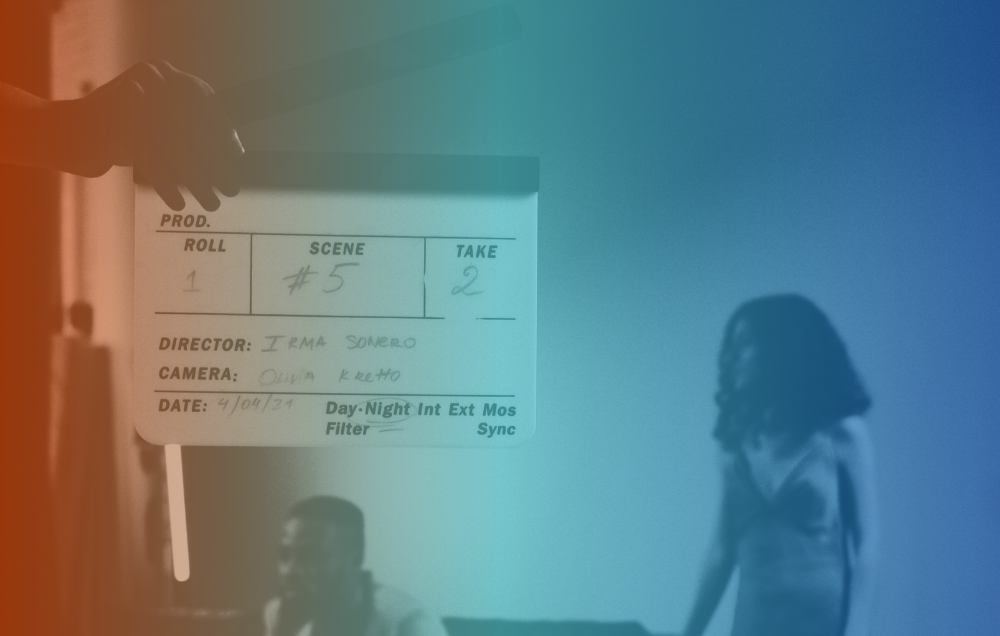A Beginner’s Guide to SAG-AFTRA Contracts
Whether you’re working on an upcoming feature or commercial, a decision you must make is whether or not you want to cast SAG-AFTRA actors.
SAG-AFTRA is a union that protects the rights of the best acting talent in the business– so it may seem like a no-brainer to work with its members. But casting SAG-AFTRA actors also requires you to follow strict contractual requirements– which aren’t easy to navigate and can get pricey, quick.
If you’re hoping to work with SAG-AFTRA talent, but aren’t well-versed in the contracts required to employ them, we’re here to help.
In this blog, we will introduce a beginner’s guide to SAG-AFTRA contracts to help you better understand the different types of production agreements and the variety of talent covered under each.
What are SAG-AFTRA Contracts?
SAG-AFTRA contracts cover all the work completed by the media performer whether they are behind the camera or mic'd up during your production. The purpose of these agreements are to develop orderly, fair and peaceful labor relationships between producers and members. Terms include:
Fair and reasonable working conditions
Effective methods for adjustments and differences to help resolve misunderstandings and disputes
Fair treatment and pay of employees
SAG-AFTRA contracts are mutually beneficial for all parties involved, however, if violated, producers are subject to fines.
Under each contract, producers, networks, studios, agencies and/or advertisers need to be aware of requirements under each stage of the production. A few general steps to be aware of include:
Pre-production: A SAG-AFTRA-signatory must be obtained prior to shooting and depending on the contract, you must either become a signatory (submit your application 4-6 weeks prior to production) or work with an authorized third-party signatory. There is also an array of documentation that must be provided to get production clearance during pre-production.
Production: Employee forms must be completed and submitted. Additionally, payroll and pension health and retirement contributions must be made within the deadline dictated under each contract. Working with a production support company can help streamline this process.
Post-production: Final Casting Lists may be due depending on the contract and final payments must be submitted within the deadlines dictated within your agreement.
Understanding your SAG-AFTRA contract for your particular production type will ensure your project runs smoothly without risking any breaches or penalties.
Types of SAG-AFTRA Contracts
There are a variety of SAG-AFTRA contracts that cover an array of performers and types of productions.
Below, we are covering a high-level overview of the following agreements:
Commercials
Corporate/Educational
Dubbing
Interactive
Music Videos
New Media
Sound Recordings
Television
Theatrical
1. Commercial Contracts
The Commercials Contract covers programs generally under three minutes in length that are used in either television, theatrical, radio and new media.
Under the Commercials Contract, there are contractual obligations advertisers and producers must follow from pre-production to wrap. A few examples include:
Pre-production: During the pre-production stage, producers must obtain a SAG-AFTRA signatory.
Production: On the shoot day of the production, you must have all talent fill out Exhibit A-1 or A-2 forms.
Post-production: After the production is complete, payment must be paid to the performer within 15 business days of the session.
What makes the Commercials agreement especially difficult to keep up with is that it’s updated every three years. In fact, SAG-AFTRA made its latest updates to its Commercials Contract provisions in April of 2022.2. Corporate/Educational (Co-Ed)
Formerly known as the Industrial Contract, the Co-Ed agreement covers various types of programs that are divided into two categories: Category I and Category II.
Category I Programs: Intended for limited exhibition (i.e., classrooms, libraries, museums, etc.) with no term limit of use.
Category II Programs: Intended for unrestricted exhibition to the general public (i.e., internet, in-store, amusement parks, airplanes, taxis, etc.) with a three-year use term.
Pro tip: B-Roll footage shot during a commercial production would also be categorized as a Category II Industrial.
3. Dubbing Contracts
The Dubbing Agreement covers performers who sing and provide voiceover dubbing English language for content that was originally produced in a different language.
There is also a Spanish Dubbing Agreement that covers performers dubbing Spanish language for content originally produced in a language other than Spanish.
Under the Dubbing Agreement, the languages covered are:
Films scripted in a foreign language being dubbed in English
Films scripted in English being dubbed in Spanish.
4. Interactive Media Contracts
The Interactive Media agreement covers video games, computer games, virtual reality games and some apps with user interaction. More specifically, it covers the performers that appear within these projects. A few examples include:
Off camera performers (voiceover)
On camera performers (stunt)
Stunt coordinators
Singers
Dancers
Background performers
5. Music Videos Contracts
The Music Video Agreement covers music video performers including:
Actors
Announcers
Dancers
Models
Narrators
Singers
Stunt performers
Choreographers and assistant choreographers are covered only for health purposes and retirement contributions. The Music Videos Agreement does not cover instrumental musicians and only up to 10 background actors are covered for budgets surpassing $50,000.
6. New Media Contracts
New Media agreements cover entertainment productions that are intended to be released on new media platforms. There are different types of New Media Contracts, including:
New Media Agreement
The New Media Agreement applies for original and derivative entertainment productions made specifically for new media platforms.
Moderate Low Budget Project
This agreement covers films shot within the US with a budget less than $700,000.
Ultra Low Budget Project
The Ultra Low Budget Agreement covers films shot within the US with a budget no greater than $300,000.
Short Project Agreement
This agreement applies to projects shot within the US with a budget no greater than $50,000 and a total run time of 40 minutes. This does not apply to episodic or animated projects.
Micro-Budget Project
This agreement is designed for independent producers who have a budget of $20,000 or less.
Projects that fall under this agreement include:
Entertainment content
Budget of $20,000 or less per picture or episode
Shot entirely within the US
Live Action
Scripted and Unscripted
Projects that have permitted exhibition to film festivals, projects that are free to the consumer new media, required screenings for Academy Award Consideration, Public Access TV, for demo purposes and in the classroom for student producers.
Projects that do not fit under the Micro-Budget agreement are the following:
Animation
Commercials
Corporate or Educational Videos
Music Videos
Audio only content (audiobooks, podcasts, radio plays, etc)
Video Games
News/Broadcast
Project that include nudity
Projects that includes hazardous stunts
Projects where the producer has received any compensation in exchange for the right to distribute or exhibit it.
7. Sound Recordings
SAG-AFTRA’s Sound Recordings Code covers recordings on digital, CDs, vinyls, audiobooks, cast albums, and other music formats alike. This contract covers talent performers, such as:
Singers
Announcers
Actors
Comedians
Narrators
Sound effect artists
Royal/Non-Royal Artists
It is important to note that under the Sound Recordings Code, the music content cannot be used in any other medium, such as television, theatrical, commercial, etc. The Music Department calls these “conversions” and will handle these claims.
8. Television Contracts
Television contracts vary depending on the type of project. These include:
Television Live Action
Television Animation
Basic Cable Live Action
Basic Cable Animation
9. Theatrical Contracts
Theatrical contracts vary based on the type of project and each has its own set of paperwork processes. The projects included are:
Theatrical (Basic or CBA)
Theatrical contract applies to films that are shooting within and outside the US with a budget greater than $2,000,000
Low Budget Theatrical (LBA)
Low Budget Agreement applies to films shooting within the US with a budget less than $2,000,000
Micro-Budget Agreement
This contract is designed for independent producers who have a project with a budget of $20,000 or less.
Ultra Low Budget Project (UPA)
Ultra Low Budget Project Agreements are for films that are shot within the US that have a budget of $300,000
Short Project Agreement
This agreement is designed for projects that are shot within the US that have a budget of $50,000 with a maximum total run time of 40 minutes not including episodic or animated projects.
Student Film Agreement
This agreement applies to student films that satisfy course requirements at an accredited educational institution shot within the US with a budget of less than $35,000 and a run time less than 35 minutes.
Moderate Low Budget Project (MPA)
The Moderate Low Budget Agreement applies to films that are shot in the US with a budget less than $700,000.
Navigate SAG-AFTRA Contracts With Ease
SAG-AFTRA contracts vary depending on the type of production and are even further categorized depending on the talent you wish to engage. Properly understanding the ins and outs of these contracts will leave you confident that your project is on the right track. Conversely, if you are not familiar with the contracts terms and regulations, they can quickly lead to increased production costs and worse– contract breaches resulting in fines.
As a third-party signatory to SAG-AFTRA Commercials, Co-Ed (Industrial) and Interactive Media Contracts, CMS Productions is happy to assist with helping you hire the best talent for your upcoming production. Contact us today to set up a consultation.
FAQs
-
SAG-AFTRA contracts cover all the work completed by the performer whether they are behind the camera or on screen during your production. The purpose of these agreements are to develop orderly, fair and peaceful labor relationships between producers and members.
-
The process to getting your SAG-AFTRA contracts signed begins with filling out a Preliminary Information form that producers can now complete online through a questionnaire. After completion, a SAG-AFTRA representative will further contact your team to complete the process.
-
Violation of SAG-AFTRA union contracts can lead to disciplinary action such as reprimands, fines or even expulsion. It is up to the SAG-AFTRA member to ensure that the company hiring them is a SAG-AFTRA signatory and that they receive a SAG-AFTRA contract when working on their project. On the other hand, a SAG-AFTRA Signatory cannot hire non-SAG talent. Similar disciplinary actions can be taken on the signatory companies.
-
No. Once a producer becomes a SAG-AFTRA signatory, they may only complete SAG-AFTRA productions moving forward. This also means you can only hire SAG-AFTRA talent for those productions. This, of course, can become expensive and add a lot of additional work for many producers. That’s why it’s encouraged that producers either sign a one production only agreement (OPO) or hire a third party union signatory when seeking to cast SAG-AFTRA talent.
-
Item descriptionAs a third-party union signatory, CMS facilitates the hiring of SAG-AFTRA talent for commercial and corporate/educational projects. As the most trusted name in union signatory services, CMS has the relationships with union locals and representatives and the contract knowledge you require to work with the best talent and performers.

